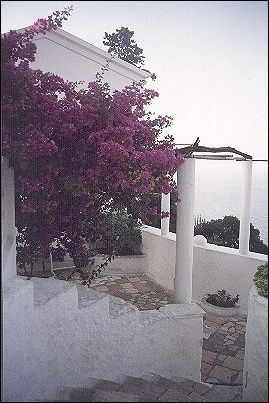
|
Cycling Corfu in the Fall
'More than enough nice spots'
In September, when the weather in The Netherlands gets rainy and colder, temperatures in Corfu still reach the lower thirties (centigrade). The summer season is over and it's possible - if you try really hard and close your eyes every now and then - to ignore the touristic ugliness. There are more than enough nice spots: pretty mountain villages, quiet roads, relatively quiet bays where the seawater still has a pleasant temperature. And last but not least the capital, where especially the Venatian quarter is still charming. All in all: enough for an enjoyable visit of a week.
Travelogue & photos: Piet de Geus
The change is huge: tonight we were biking through foggy Amsterdam, on a nasty water-cold September night, and now, 9:30 AM, it's already over 20 degrees centigrade when I descend the stairs of the airplane. Later in the day it gets in the thirties. When the first pieces of luggage arrive on the conveyor belt, I have already changed into biking wear and am completely ready.
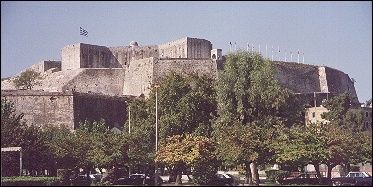 |
A little later we enter Kerkyra (or Corfu) City by bike, a wonderful city at first sight. We immediately ride from highlight to highlight: the Esplanade and the old and new fortresses.
We easily manoeuvre in the busy traffic, which gets stuck every now and then: buses, motor bikes, scooters, jeeps and horse carriages with tourists.
In an outdoor café with a view of the harbour where the ferries leave, we have our first doppio Greek coffee. And another one at the new fortress. We leave the city northward via the same busy - and now also dusty - road we entered. The views of the coast are sometimes beautiful, sometimes scary and disgusting because of mass tourism. After a dozen kilometers we leave the coastal road to avoid the Ipsos and Dassia hills. As soon as we are on a country road to Kato Korakiana the surroundings are really beautiful: blooming bushes on the sides of the road, the light filtered by ancient olive trees and every now and then a pretty hamlet. Meanwhile we have to make a tough climb biking on rather bad asphalt. Every now and then we have a view of the coast, the sea and in the distance the contours of Albania.
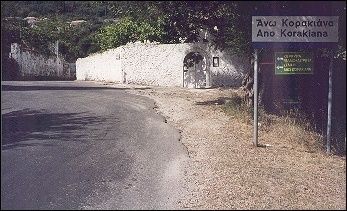 |
We drink lemonade below a canopy of grapevines in Kato Korakiana. Trucks stacked with crates of grapes drive by. Apart from that, nothing disturbs the siesta, even the parakeet in its cage outdoors is relatively quiet.
After some climbing and descending a bend in the road takes us back to the coast. While we zoom down, we see to our right the mess we skipped: parasailers, jet skis and crowded beaches with behind them a succession of vacation home parks and hotels.
Back on the coastal road, the only paved road east of Mt. Pandokrator, we can't escape the tourist craziness: guys with bare uppper bodies on motor bikes, shocking pink jeeps filled with all kinds of idiots, whose common characteristics are that they are red from sunburn, loud and wear silly sun hats.
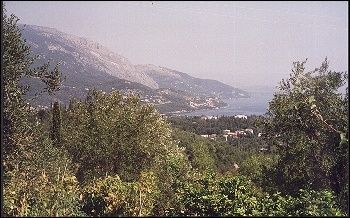 |
Our route is also getting more exhausting, with short, tough climbs. The fatigue of a sleepless night gets the better of us and the heat becomes muggy. But we still keep bicycling, every now and then passing through a nice village; it also gets less crowded. After 44 kilometers we arrive in Kalami. Tired, exhausted and irritated, but also full of new impressions.
Kalami turns out to be more touristic than last year's guidebooks wrote: a hideous apartment complex sits on the road above the village. But the only street in the village itself winds beautifully around a small bay and the houses are idyllically located between trees. It's easy to find a room and a little later - after a much needed shower - we sit in a taberna on the gravel beach, eating grilled swordfish. Around 9:30 PM I am dead tired.
Bicycling? To the beach!
I decide to ignore the water scooters and enjoy myself
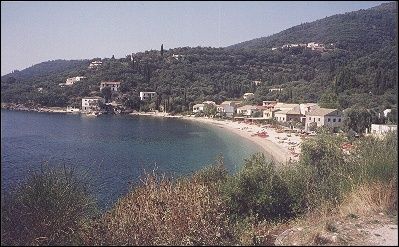 |
I must have been completely exhausted yesterday: it turns out I left my bicycle bag with my camera, lenses, passport and money on our terrace. Fortunately our neighbors were nice enough to take it inside; if they hadn't it would have been a short vacation.
When we mount our bikes around 10 AM, everyone else is going to the beach. They are right: it's actually too hot already to do anything else then swim. And immediately we have to climb for 4 long kilometers to Agnitsini. We are sticky because we sweat so much, and we don't get ahead very much. Despite the toiling we realise that the views of bays and villages that disappear in the deep must be very beautiful for someone who pays attention.
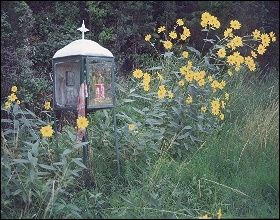 |
Finally, after a bend, we see Agnitsini: sitting outside in the shade of grapevines, we have coffee and water. Old men at a table next to us play backgammon. Motor bikes, scooters and open jeeps with tourists pass by all the time, their speed protecting them from the heat. In the summer, the crowds and temperatures here must be unbearable.
We skip Kassiopi, which should be worthwhile. "Skip" is an understatement: we virtually fall past it during a refreshing descent. We also pass on a pretty, 16 kilometers long detour through the inland. The pull of the beach is too strong. We can't find a room in Astrakeri: if you plan on staying only one night, they get nasty here and all of a sudden are booked up.
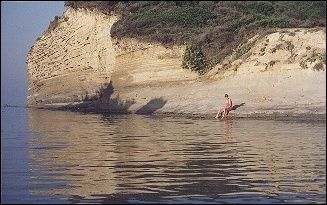 |
Ten kilometers further in Sidari we have more luck, even though we are now in a tourist resort full of Brits. At 3 AM we take a dive in the sea, between extraordinarily beautiful sandstone cliffs. I decide to ignore the water scooters and speedboats with parasailers in their wake, and to enjoy myself.
That plan succeeds, until it's time to go to bed. Somewhere in our street, around mignight, the karaoke begins: A drunk Brit hollers Oh Delilah. I doubt that he'll be pelted with ladies' panties.
Over the Trumpet Pass
Deep below us lie scattered villages
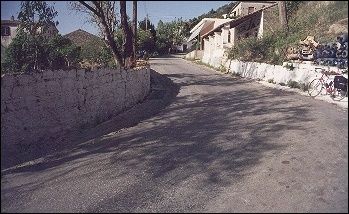 |
We leave Sidari at 8 AM, this time we will beat the heat to it. The road to Kavadades winds through the fields, almost imperceptibly going up. After six kilometers and some hairpin turns we enter Kavadades, a picturesque village with no tourist in sight. A grocery store doubles as coffee bar with two small tables.
We continue on a beautiful route: up and down, turn and turn again, passing through Armenades, again one of those quiet mountain villages. A few turns of the road farther we already see Arkadades far below us. We ride in the fairy-like shade of a dense olive grove. The leaves glitter in the sunshine. Via Dafni and Aspiotoades the road takes us to Arkadades, all three of them picturesque villages.
Then we climb in the burning heat on a road with busy truck traffic to the Troumbetas pass, known among bikers as "Trumpet Pass", at 430 meters. There are two tabernas on the pass, it's an ideal spot to sit down and rest indeed. To our right, a quiet road winds its way to the real summit. Then we descend for a while, until the road goes up again to the next peak at 500 meters. At this altitude, the road meanders between vineyards, deep below us are scattered villages. The views of both the northern and southern parts of Corfu are a little disapointing, because of the haze. Only every now and then we can see a grey strip of sea.
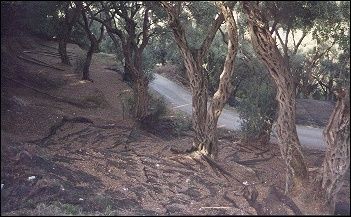 |
Vineyards make place for olive groves again and we reach Makrades via Vistonas. There are booths along the raod with home-made wine, olive oil, honey, carpets and other souvenirs. Buses bring tourists here for excursions from the tourism-swamped south of Corfu. Tourist traffic increases by the kilometer here.
Turning and winding through short bends we descend between olive groves until we arrive at taberna Prima Vista, a famous viewing point near Lakones at 300 meters. The roadsides are jammed with buses, cars, scooters and motor bikes. We are the only bicyclists at this altitude and are stared at while we weave through the traffic jam.
It's hard to find a table to have an iced coffee. Despite the haze the view is spectacular: at a short distance, Lakones lies as if glued to a steep rock wall and straight below us are the bays of Paleokastritsa. I am beginning to understand the surprised looks we got: if you would ride your bike up from this side, you'd undoubtedly look a lot less fresh than we do.
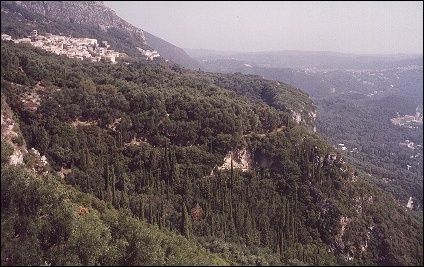 |
We stop again in Lakones. Here is the workshop of Alkiviades, reportedly the best olive-woodworker in all of Greece.
The wooden goods and utensils in the small shop are very beautiful indeed, so we pack our bicycle bags with souvenirs.
We descend six kilometers to Paleokastritsa in only a few minutes. Via numerous turns the road goes steeply down; our break pads are tested to the limit. There are more turns in Paleokastritsa itself, along a series of bays. Just before we reach the fishing port, we see a sign "rooms for rent" between the olive trees. A concrete stairway leads us down into a grove, which also has a flower garden and a kitchen garden. We're in luck: a room is available. One look at the shady terrace is enough to book it for three days. Below the terrace lie fishing boats in the scorching sun.
We immediately change and descend through the garden to the next, private, stairway. Now we are on the beach next to the port and we have it all to ourselves. We get in the water and swim between boats and fish.
An extra ride
The only post office on the island is in Corfu City
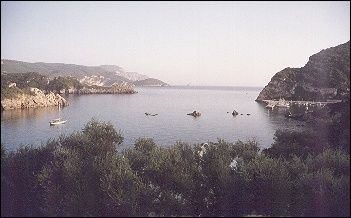 |
Wonderful, three days of lazying. Or so we thought, until we asked about a post office yesterday evening. It turns out the yellow container that served as one is closed since last year. The only post office on the island is in Corfu City, over 25 kilometers from here. So our alarm goes again at 7 AM.
When we leave Paleokastritsa we see how the morning fog hangs between the mountain, then moves over the peaks and eventually is blown to shards over the sea. At first we climb between two rock walls and then we zoom at a pace of a little over 30 k/p/h almost imperceptibly up and down from the west to the east coast.
It's still wonderfully cool and the drops of condensation bring extra freshness. That's a good thing, because we forgot to bring our bidons and we don't feel like going back for them. A little later we are on the coastal road and speed through the morning rush into Kerkyra (Corfu City).
We quickly cash some checks at the post office, have a cup of coffee in an outdoor café, buy provisions and water and then take a beautiful route back to Paleokastritsa. Meanwhile the sun has broken through the haze and the temperature quickly passes 30 degrees centigrade. So we get more bottles of water to drink on the way. Shit, they don't fit in the bidon holders. Because I am the only one with a bikers shirt, with those handy back-pockets, I am the shmuck who gets to carry the water. When my girlfriend has the temerity to look back when I stay behind a little, I yell at her that instead of continuing to ride, she should continue to drink.
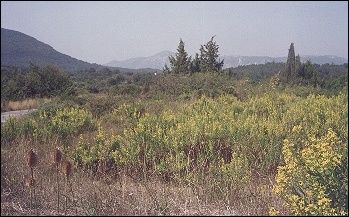 |
First we ride to Agio Ioannis, where we have lunch on the pretty village square. We also visit a bicycle service center to buy a spare tire.
The conversation there is predictable: we should have tractor tires for a vacation like this. This is a place where they rent out ATBs and many of their customers are campers who load tents, sleeping bags and complete kitchen equipments on their bikes. They don't understand that it's nicer to bicycle on 20-22 milimeters tires if you don't have all that dead weight. We purchase another 3/4 liter bidon (with showerhead, who comes up with such nonsense!) and bring our tires to maximum tension, using a manometer.
A little later we bump happily on a quiet country road through the Ropa plain, which lies between the ranges of hills on the east and west coasts. In the distance we already see, between the mountains, the canyon near the bays of Paleokastritsa. We pass a gypsy camp. Broom spreads its scent from the roadside where lizards scuffle. Unexpectedly a fresh wind rises; it's a pity that it should be a headwind. Typically Dutch.
When the the electric light signs come on
Swimming between rocks and colorful fish
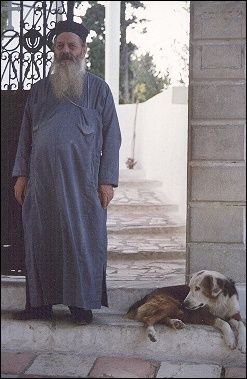 |
Paleokastritsa is rather touristic, but because it doesn't have a real center and because its only road winds between woods along several bays, it's still enjoyable. At the end of the (dead end) road are three beaches. The middle one, where the excursions by boat to the caves leave, is overcrowded. The one on the left, near the port, is deserted. But the best place to swim is the beach on the right, just follow the signs to the diving club. It's relatively quiet there and you swim between rocks, while colorful fish swim beneath you. No wonder people come here to snorkle.
Paleokastritsa is recommendable during the daytime. The only problem is finding a decent restaurant. Everywhere the food is adapted to the taste of the average (English) tourist. When I ask about tzatziki, it is recommended with the announcement that there isn't too much garlic in it. I've heard enough and order tomato soup instead.
We also have to eat fast, because half-way our main course the staff begins their inevitable dancing. After ten minutes the ladies are invited to join. Especially middle-aged women (both the ones in flower-print dresses and the ones in leggings) are eager to participate in the sirtaki, meanwhile throwing glances at their spouses that say "See, John? When was the last time you asked me to dance?!"
The special attraction here is a firedance: the lights go out, a circle is made with a bottle of spirit, then lighted, and someone dances in the circle. Extra special: a waiter lifts two stacked tables between his teeth. We decide to have coffee on our own terrace, where we have some peace and quiet.
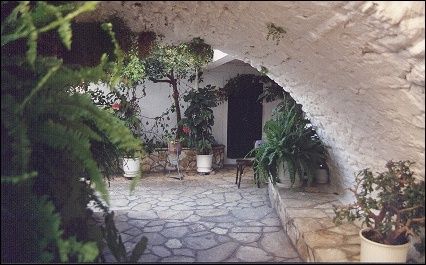 |
The same music blares from bad sound systems in all restaurants. Even the invitation to join in the dance is already on tape in English.
Between the restaurants are bars and discotheques, each with their own evergreens. All these sounds are mixed into an undifferentiated noise that spreads over the bays. As green as it looks during the daytime, as soon as the lights and the electric light signs come on, everything changes. Left, right, up and down, everywhere are restaurants, bars, souvenirs booths, money changing offices, supermarkets, etc. They all carry "tourist information" signs.
Turkeys in the monastery
The view from the parapet is spectacular
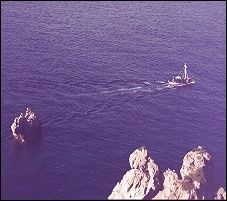 |
Again the alarm goes at seven in the morning. This time not to stay ahead of the sun, but of the daily busloads of tourists who visit the local monastery. The monastery sits on a hundreds of meters high rock near the port. That is a great location, especially because it used to double as a fortress.
When we arrive after climbing up the steep road to the monastery, our strategy turns out to have worked: we have the monastery all to ourselves and wander undisturbed through the beautiful cloisters full of potted plants. The monastery church with icons and silver chandeliers is nice, but what is really spectacular is the view from the parapet: far below is fishing boats sail between the rocks.
While we leave through the monastery gate, three women with brooms drive a flock of turkeys into the monastery garden. A monk leads the way and tries to lure the animals with his voice, but the brooms are more effective. When we arrive at the bottom of the road to the monastery, the first buses with tourists arrive.
Pretty mountain villages
Palm trees on the square and charming stepped streets
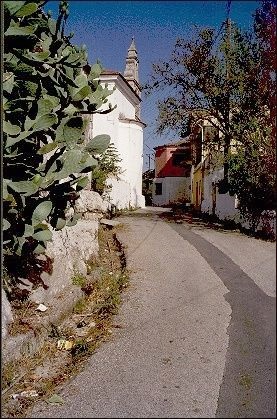 |
We leave for Corfu City, again taking a different route. The first leg goes again through the Ropa plain and then we turn right, for a hilly leg on narrow roads passing through the mountain villages Kanakades and Marmaro. We climb on a winding road and enter Gianades where we continue on to a square that ends in a kind of balcony with a wonderful view of the Ropa plain.
We zoom delightfully up and (mainly) down to Ermones on a road lined with blooming bushes and cactuses. The climb to Vatos is nasty, but after that a relativly easy leg follows to Sinarades, a jewel of a mountain village with palm trees on the square and charming stepped streets. From there we continue on snaking roads with bumps and potholes between olive groves to the east coast. Near Viros, which is even hardly a hamlet, we see the sea shine far below us.
We enter Kerkyra via a dam through a swamp near the airport. At the end of the dam we push our bikes up to the viewing point from where all photos of the Vlacherna monastery island are taken, which you find in almost all travel guides, brochures and posters about Corfu.
On the Esplanade we see some remnants of British rule: a game of cricket is played on a field. A little later a brass band marches by, dressed in British looking outfits.
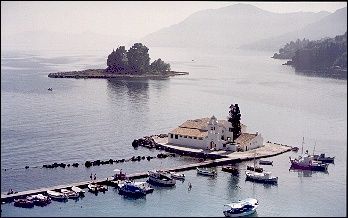 |
It's easy to find private rooms everywhere in Corfu, but in the capital we don't see any signs "rooms to let". The guidebooks don't mention any addresses either. Still we find a room, by accident.
When we walk on the Esplanade looking for signs, the owner of a souvenir shop approaches us. Are we looking for a hotel? No, we want a private room. In that case, we should go to a nearby restaurant and ask. Sit down, my colleague will make a phone call, says the waiter there. Within minutes a woman arrives who shows us several rooms. Eventually we accept the room of her downstairs neighbor Maria, who isn't home and doesn't know anything about it. Later in the evening we get acquainted when she brings us a plate of grapes.
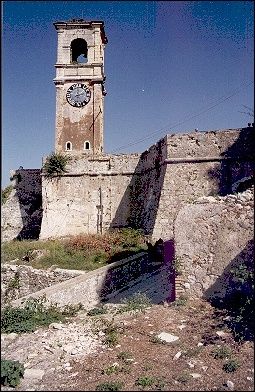 |
Are we happy with the room. Yes, we are, its comfortable and "tastefully" decorated. The floor is parquet, at least vinyl with a parquet pattern. On the few square meters are two beds and a collection of closets, dressers, occasional tables and chairs. If you open the shutters, you can steal the cheese off the neighbors' sandwiches: the street is barely two meters wide. Everywhere in the room stand or hang old photos of relatives, quite homey. But I am mostly charmed by the altar that Maria has built on the dresser.
On the dresser stands a huge painting of the other Mary, which is illuminated by a red light. Mary is dark-brown because of her long exposure to light and tobacco smoke, the paint flakes in large pieces off her body. There also is a reproduction of a sad Jesus and a noble Mary, which you watch through cut-aways in a gold-colored (but tin) front. In the same manner, but silver-colored, is the picture of a saint next to it.
On the other side is a cut-out picture of Jesus on the cross, a bouquet of plastic flowers at his feet. And then there is a relief of Mary with the child Jesus, also illuminated by a little light. Moreover there are a picture of the crucifixion, flanked by two crucifixes, another picture of Mary with the child Jesus, a picture of Jesus healing a sick person, and a picture of a saint on a horse behind slats (looking from the left, there's a picture of Mary solo on the slats, looking from the right you see Mary with the child Jesus for a change). There also is a photo of a procession and - last but not least - a picture of Jesus with a crown of thorns, in a flat waterbottle.
Venetian Quarter
A maze of narrow streets and squares
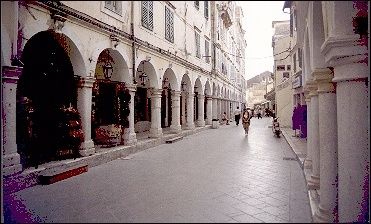 |
Our first impression of Kerkyra, when we bicycled through it fresh from the plane, was already that it is an atmospheric city. That impression is confirmed when we wander through the Venetian quarter Cambiello.
It is a maze of narrow streets with buildings with five or six floors. Every few meters there's a church or a square. Here and there balconies are converted into aviaries with songbirds. The somewhat wider shopping streets look majestic with their arcades and marble paving.
Behind the Esplanade lies, on a rocky hill in the sea, the former fort, the contrafontessa, separated from the mainland by a deep canal full of boats. In the Ayios Yiorgos church, built by the British in 1840, we see an exhibition of paintings which are remarkable for their beautiful use of color.
After leaving the church we climb on in the heat. All the way at the top, at an altitude of seventy meters, someone had the bright idea to sell cans of soda. From here you can clearly see how the city is hemmed in between the old and new forts. We enjoy the views of the city, the Albanian coast behind the sea, the mountains, actually of most of our biking route. A wonderful goodbye to this island.